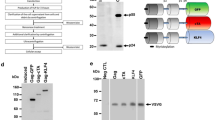Abstract
Bacteriophage T7 RNA polymerase and a derivative containing a nuclear localization signal were transiently expressed in CV-1 cells and were shown to localize to the cytoplasm and nucleus, respectively. A vector was constructed containing T7 promoter and transcription terminator sequences flanking a picornaviral 5′ untranslated sequence for cap-independent translation and a polyA signal. Expression of the HIV-1 envelope glycoproteins in this vector system gave high levels of specific transcripts and translation products, independent of the subcellular localization of T7 RNA polymerase. The synthesis of HIV glycoproteins was also completely independent of the coexpression of the HIV rev protein, which is normally required for the expression of HIV structural proteins. In addition, a poly A signal was not required, whereas the presence of the picornaviral 5′ untranslated region was necessary for efficient expression. Different possibilities to account for these findings are discussed. The HIV glycoproteins synthesized in this system were normally processed and assembled; they could induce syncytium formation and complement anenv-deletion mutant of HIV-1.
Similar content being viewed by others
References
Bosch V. and Pawlita M., J Virol64 2337–2344, 1990.
Chamberlin M., McGrath J., and Waskell L. Nature228 227–231, 1970.
Dunn J.J. and Studier F.W., J Mol Biol166 477–535, 1970.
Fuerst T.R., Niles E.G., Studier F.W., and Moss B., Proc Natl Acad Sci USA83 8122–8126, 1986.
Fuerst T.R., Earl P.L., and Moss B., Mol Cell Biol7 2538–2544, 1987.
Fuerst T.R. and Moss B., J Mol Biol206 333–348, 1989.
Elroy-Stein O., Fuerst T.R., and Moss B., Proc Natl Acad Sci USA86 6126–6130, 1989.
Deuschle U., Pepperkok R., Wang F., Giordano T.J., McAllister W.T., Ansorge W., and Bujard H., Proc Natl Acad Sci USA86 5400–5404, 1989.
Lieber A., Kiessling U., and Strauss M., Nucleic Acids Res17 8485–8493, 1989.
Benton B.M., Eng W.-K., Dunn J.J., Studier F.W., Sternglanz R., and Fisher P.A., Mol Cell Biol10 353–360, 1990.
Dunn J.J., Krippl B., Bernstein K.E., Westphal H., and Studier F.W., Gene68 259–266, 1988.
Felber B.K., Hadzopoulou-Cladaras M., Cladaras C., Copeland T., and Pavlakis G.N., Proc Natl Acad Sci USA86 1495–1499, 1989.
Malim M.J., Hauber J., Le S.-J., Maizel J.V., and Cullen B.R., Nature338, 254–257.
Mermer B., Felber B.K., Campbell M., and Pavlakis G.N., Nucleic Acids Res18 2037–2044, 1990.
Ratner L., Haseltine W., Patarca R., Livak K.J., Starcich B., Josephs S.J., Doran E.R., Rafalski J.A., Whitehorn E.A., Baumeister K., Ivanoff L., Petteway S.R., Jr., Pearson M.L. , Lautenberg J.A., Papas T.S., Ghrayeb J., Chang N.T., Gallo R.C., and Wong-Staal F., Nature313, 277–284.
Adachi A., Gendelman H.E., Koenig S., Folks T., Willey R., Rabson A., and Martin M.A., J Virol59 284–291, 1986.
Rosenberg A.H., Lade B.N., Chui S.-W., Dunn J.J., and Studier F.W., Gene56 125–135, 1987.
Parks G.D., Duke G.M., and Palmenberg A.C., J Virol60 376–384, 1986.
Zoller M.J. and Smith M., DNA3 479–488, 1984.
Döffinger R., Pawlita M., and Sczakiel G., Nucleic Acids Res16 11840, 1988.
Chomczynski P. and Sacchi N., Anal Biochem162 156–159, 1987.
Harada S., Koyanagi Y., and Yamamoto N., Science229 563–566, 1988.
Towbin H., Staehelin T., and Gordon J., Proc Natl Acad Sci USA77 5201–5205, 1979.
Jang S.-K., Kräusslich H.-G., Nicklin M.J.H., Duke G.M., Palmenberg A.C., and Wimmer E., J Virol62 2636–2643, 1988.
Jang S.-K., Davies M.V., Kaufman R.J., and Wimmer E., J Virol63 1651–1660, 1989.
Helseth E., Kowalski M., Gabuzda D., Olshevsky U., Haseltine W., and Sodroski J., J Virol64 2416–2420, 1990.
Zhou Y., Giordano T.J., Durbin R.K., and McAllister W., Mol Cell Biol10 4529–4537, 1990.
Chen W., Tabor S., and Struhl K., Cell50 1047–1055, 1987.
Author information
Authors and Affiliations
Rights and permissions
About this article
Cite this article
Wilk, T., Mierswa, H., Kräusslich, HG. et al. Expression of biologically active HIV glycoproteins using a T7 RNA polymerase-based eucaryotic vector system. Virus Genes 6, 229–246 (1992). https://doi.org/10.1007/BF01702562
Received:
Accepted:
Issue Date:
DOI: https://doi.org/10.1007/BF01702562




